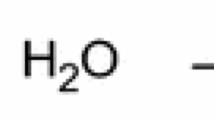Abstract
A novel antibacterial and flame-retardant agent, monochlorotriazine triethylphosphite guanidine (MCTPG) was synthesized successfully. The chemical structure of MCTPG was characterized by FTIR and 1H NMR. The flame retardancy of treated cotton fabric was evaluated by limiting oxygen index (LOI), the vertical burning test and cone calorimeter, respectively. The treated cotton fabric obtained good flame retardancy with a LOI value of 31.2%, and the char length decreased to 8.5 cm. The ignition time increased, and the values of total heat release, heat release rate, mass loss decreased. The thermal stability and surface morphology of treated cotton fabric were investigated by thermogravimetric analysis and scanning electron microscope (SEM), respectively. The results showed that MCTPG played a protective role in the degradation of cotton fabrics, hindered the formation of volatile species and favored the formation of char. Furthermore, the antimicrobial activity of treated cotton fabrics was tested. And it showed that the inhibition zone of the treated cotton fabrics base to Escherichia coli and Staphylococcus aureus reached to 2.9 mm and 2.8 mm, respectively.















Similar content being viewed by others
References
Liu W, Chen L, Wang YZ. A novel phosphorus-containing flame retardant for the formaldehyde-free treatment of cotton fabrics. Polym Degrad Stab. 2012;97(12):2487–91.
Leslie AW. Preparation and thermal analysis of cotton–clay nanocomposites. J Appl Polym Sci. 2004;92:2125–31.
Dennis P, Liu Y. Burning behaviour of foam/cotton combinations in the cone calorimeter. Polym Degrad Stab. 2002;77(2):213–20.
Cullis CF, Hirschler MM. The flame retardance of a natural polymer by sulphur-aluminium-bromine system. Eur Polym J. 1984;20(6):559–62.
Hou A, Sun G. Multifunctional finishing of cotton fabrics with 3,3′,4,4′-benzophenone tetracarboxylic dianhydride: reaction mechanism. Carbohydr Polym. 2013;95:768–72.
Hou A, Zhang C, Wang Y. Preparation and UV-protective properties of functional cellulose fabrics based on reactive azobenzene Schiff base derivative. Carbohydr Polym. 2012;87:284–8.
Mostashari SM, Mostashari SZ. Combustion pathway of cotton fabrics treated by ammonium sulfate as a flame-retardant studied by TG. J Therm Anal Calorim. 2008;91:437–41.
Abou-Okeil A, Ei-Sawy SM, Abdel-Mohdy FA. Flame retardant cotton fabrics treated with organophosphorus polymer. Carbohydr Polym. 2013;92:2293–8.
Horrocks AR, Kandola BK, Davies PJ, Zhang S, Padburg SA. Developments in flame retardant textiles—A review. Polym Degrad Stab. 2005;88:3–12.
Yang CQ, He Q. Applications of micro-scale combustion calorimetry to the studies of cotton and nylon fabrics treated with organophosphorus flame retardants. J Anal Appl Pyrolysis. 2011;91:125–33.
Alongi J, Colleoni C, Rosace G, Malucelli G. Thermal and fire stability of cotton fabrics coated with hybrid phosphorus-doped silica films. J Therm Anal Calorim. 2012;110:1207–16.
Jiang J, Li J, Hu J, Fan D. Effect of nitrogen phosphorus flame retardants on thermal degradation of wood. Constr Build Mater. 2010;24:2633–7.
Hu S, Hu Y, Song L, Lu HD. The potential of ferric pyrophosphate for influencing the thermal degradation of cotton fabrics. J Therm Anal Calorim. 2012;109:27–32.
Chen YZ, Peng HQ, Li JH, Xia ZX, Tan H. A novel flame retardant containing phosphorus, nitrogen, and sulfur: synthesis and application in thermoplastic polyurethane. J Therm Anal Calorim. 2014;115:1639–49.
Yuan DD, Yin HQ, Cai XF. Effect of a novel flame retardant containing silicon and nitrogen on the thermal stability and flame retardancy of polycarbonate. J Therm Anal Calorim. 2013;111:1531–7.
Lim SH, Hudson SM. Application of a fiber-reactive chitosan derivative to cotton fabric as antimicrobial textile finish. Color Technol. 2004;56(2):227–34.
Bshena O, Heunis TD, Dicks LM, Klumperman B. Antimicrobial fibers: therapeutic possibilities and recent advances. Future Med Chem. 2011;3(14):1821–47.
Wang C, Lv J, Ren Y, Chen QZ. Cotton fabric with plasma pretreatment and ZnO/Carboxymethyl chitosan composite finishing for durable UV resistance and antibacterial property. Carbohydr Polym. 2015;138:106–13.
Mohsin M, Sarwar N, Ahmad S, Rasheed A. Maleic acid crosslinking of C-6 fluorocarbon as oil and water repellent finish on cellulosic fabrics. J Clean Prod. 2016;112:3525–30.
Wang CS, Shieh JY, Sun YM. Phosphorus containing PET and PEN by direct esterification. Eur Polym J. 1999;35:1465–72.
Sahariah P, Óskarsson BM, Hjálmarsdóttir MÁ, et al. Synthesis of guanidinylated chitosan with the aid of multiple protecting groups and investigation of antibacterial activity. Carbohydr Polym. 2015;127:407–17.
Nazare S, Kandola B, Horrocks AR. Smoke, CO and CO2 measurements and evaluation using different fire testing techniques for flame retardant unsaturated polyester resin formulations. J Fire Sci. 2008;26:215–42.
Kandola BK, Horrocks AR, Price D, Coleman GV. Flame-retardant treatments of cellulose and their influence on the mechanism of cellulose pyrolysis. J Macromol Sci. 1996;36:721–94.
Tsafack MJ, Levalois-Grutzmacher J. Flame retardancy of cotton textiles by plasma-induced graft-polymerization (PIGP). Surf Coat Technol. 2006;201:2599–610.
Acknowledgements
This work was supported by the Scientific Research Foundation for the Returned Overseas Chinese Scholars, State Education Ministry.
Author information
Authors and Affiliations
Corresponding authors
Rights and permissions
About this article
Cite this article
Dong, C., He, P., Lu, Z. et al. Preparation and properties of cotton fabrics treated with a novel antimicrobial and flame retardant containing triazine and phosphorus components. J Therm Anal Calorim 131, 1079–1087 (2018). https://doi.org/10.1007/s10973-017-6604-x
Received:
Accepted:
Published:
Issue Date:
DOI: https://doi.org/10.1007/s10973-017-6604-x




